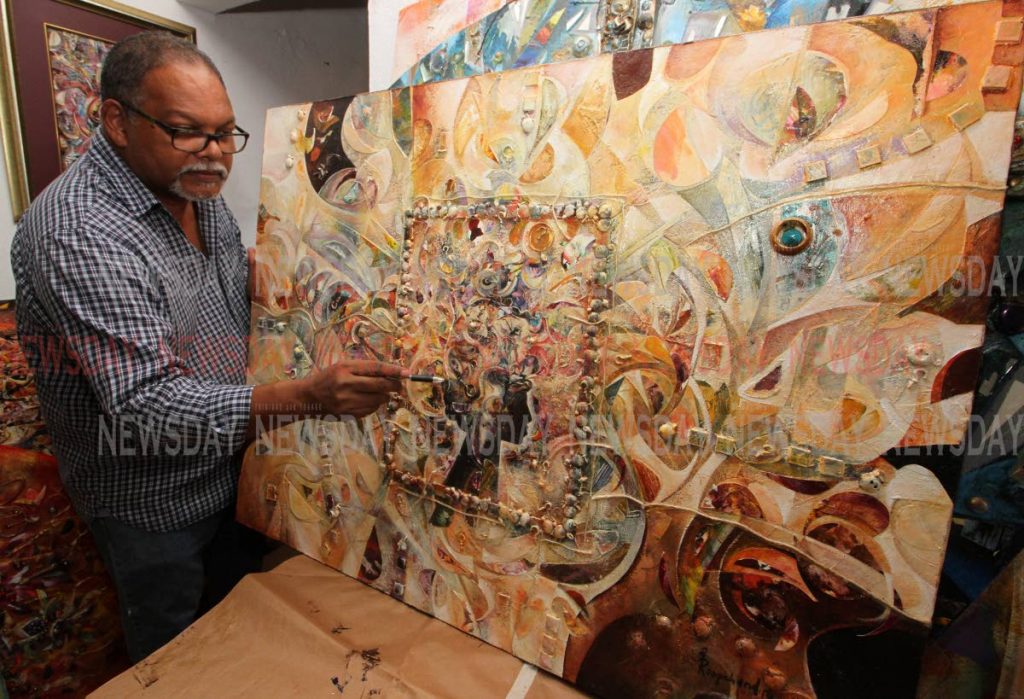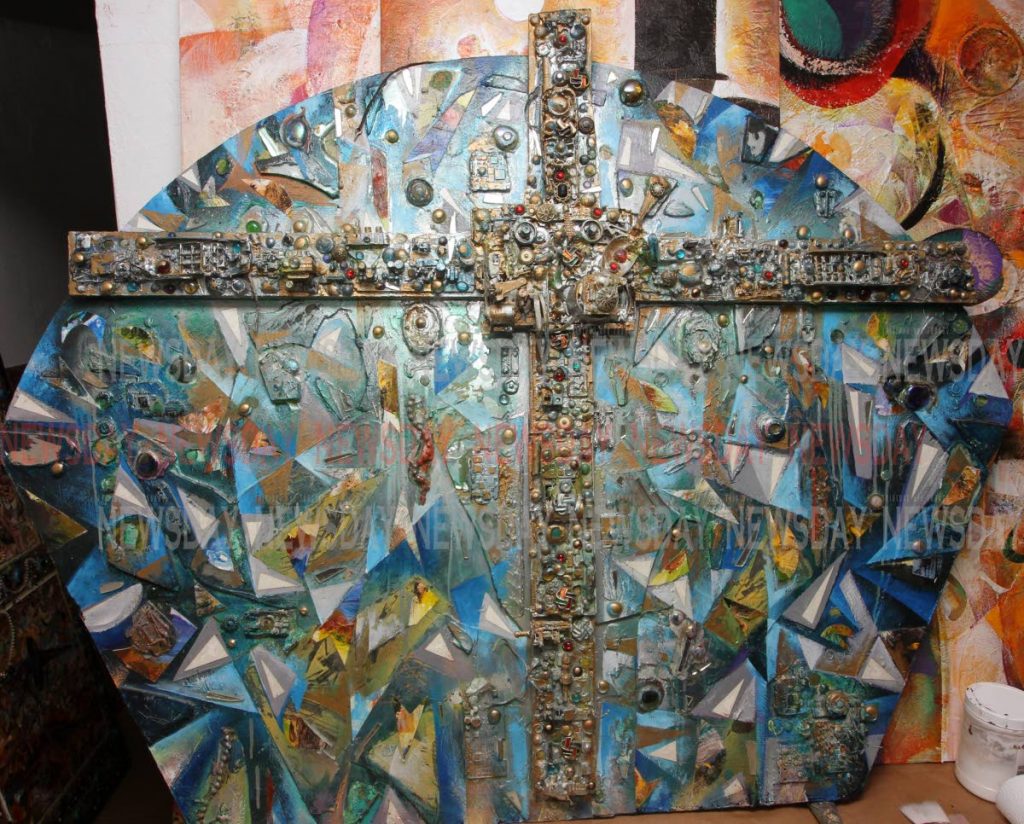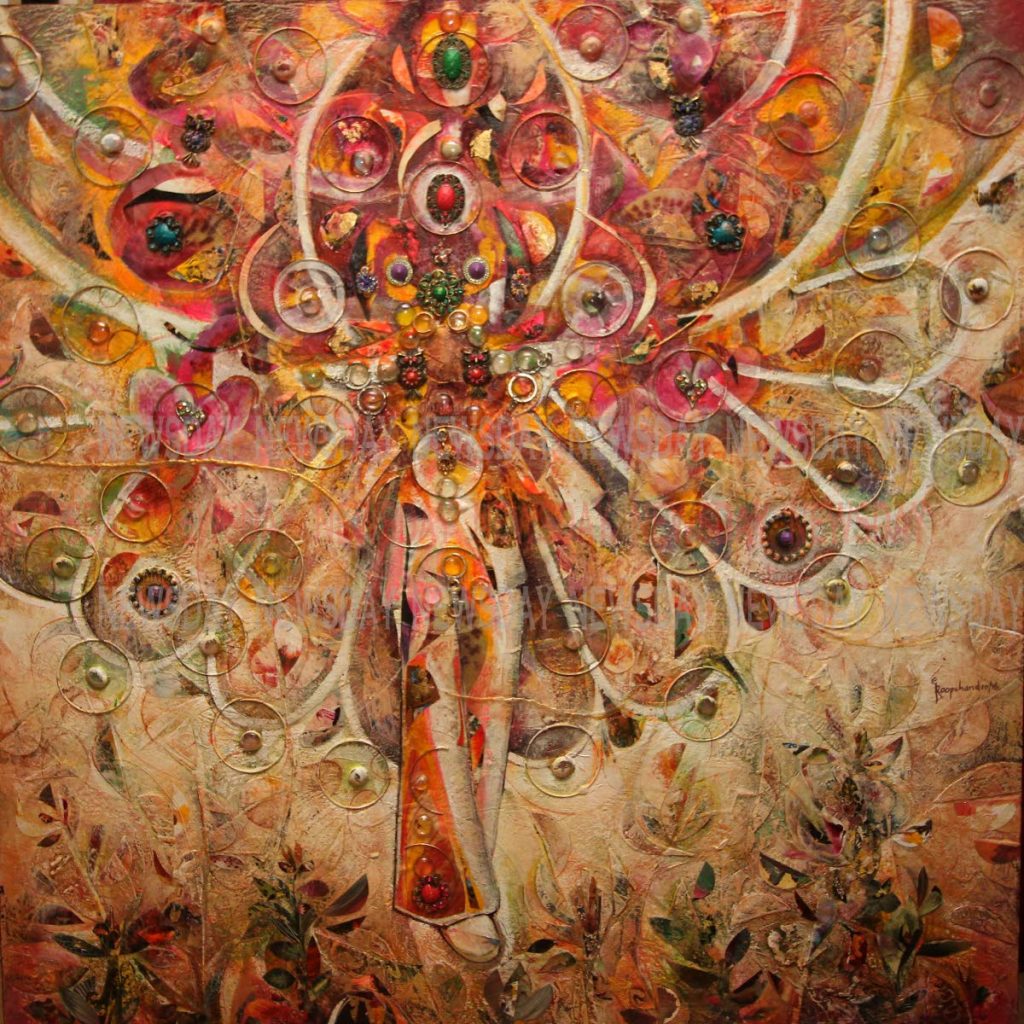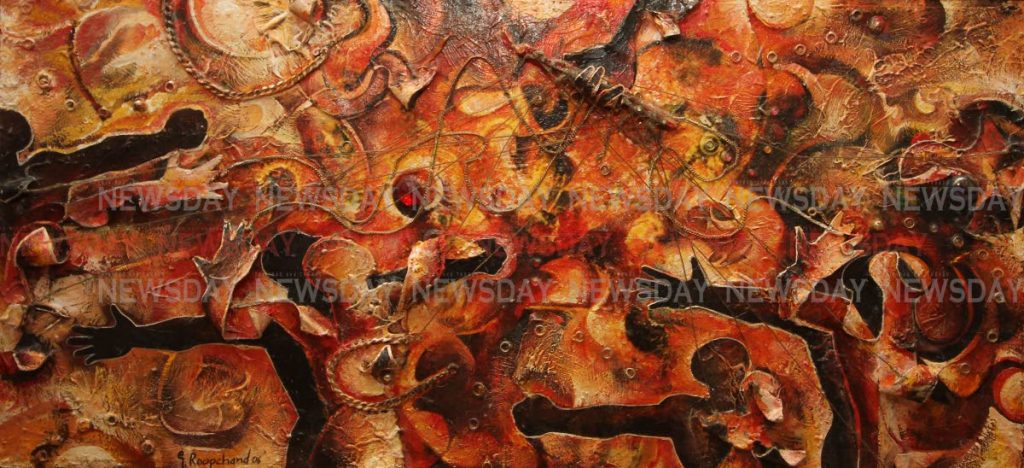Parade, art of the feminine principle

The word “organic” comes to mind when looking at Glenn Roopchand’s pieces for his Parade exhibition.
His mixed media paintings are full of earth tones. And even when bright colours are used, they are muted by others. He also uses found objects including beads, wire, stones, sea shells, hooks, twine, earrings, mirrors, and more to create texture and add dimensions to the pieces. Therefore some of his pieces can seem busy, but because of the shapes, colours and flow, they catch the interest rather than being too much.
Roopchand, 67, is hosting his 25th solo exhibition, Parade, at 101 Art Gallery in Newtown, Port of Spain from August 18 to 22. His themes include African and Indian culture, Carnival, religion, the divine, and more, but according to Roopchand, it all comes under the umbrella of the feminine principle. “I believe that the universe is feminine. Masculinity is an attribute of femininity. The reason why the world as we know it is feminine is because of procreation.”
Medium Corporation website writer James Knox condensed the idea of the feminine principle saying, “This symbol of passivity and creativity is explaining that everything that comes from the unknown must first be received and then birthed into the known. The receptive quality of the feminine allows us to receive knowledge from the unknown. The creative quality of the feminine allows us to birth this knowledge into the world. Without the feminine principle this would be impossible.
“The receptive feminine is the “mysterious intuition” which brings forth knowledge from the Way or the Tao, which is the source of all being. “The gateway of all subtleties” is the receptive feminine. It is not based on gender, whether male or female, this receptivity is essential to be in contact with the Tao. The feminine is vital in developing intuition.”
Roopchand stressed that his inspiration was not about truth because truth was relative but as an artist he was free to express the ideas in his mind in different terms. One of those terms was mas. “I have always tried to find a methodology that relates to who we are. And I try to use a kind of symbolism that we are accustomed to.”
He was involved with mas design for many years in the 1970s. From age 14 he worked under Carlisle Chang, a designer for bandleader Stephen Lee Heung, and associated with people from whom he learned different disciplines such as sculpture, metal work, and painting.

His aesthetic of mixed media paintings could also be attributed to Carnival. “I was a masmaker and my job was to cut and stick things together. In the 60s and 70s we had to be innovative because we didn’t have certain technology. All the plastic forms people are using now are things we tried to create out of whatever material we could find.”
He said this work made him fall in love with texture and he applied what he learned to his art. “I think that we are the afterbirth of a cosmic consciousness so that every form and every shape we could identify is something that was there before. So texture assists me with dealing with the subconscious.”
He said he was fascinated with the Parade of the Bands because he saw it as “an unfolding of a kind of consciousness.” He interpreted TT culture through the parade and saw it as a journey or parade of life in general – frolicking, care taking, education, etc – into forever.
He believed mas was not just people dressing up and dancing on the street but it had a deeper meaning. He said in the animal kingdom the males often parade themselves to attract a mate and Carnival was similar.
“Carnival is a performance, a parade of procreation. We look at Carnival and see half naked men and women and say they are vulgar but psychology tells you that its necessary in a society because you have to find a way of parading yourselves. Why do we wear special shoes, or shine our shoes? Why do we wear our shirt inside our pants, or wear lipstick. It’s not just about feeling to do something. It’s a parade. It’s wanting people to see you and like you.”

Art of Caribbean consciousness
Roopchand studied Graphic Arts at John Donald Technical Institute. He entered the Prime Minister’s Best Village art competition and won a gold medal as well as a scholarship to study in the United States at Pratt Institute, and later The Art Students League of New York. After school he returned to TT and taught at El Dorado Senior Comprehensive School for 11 years before moving to New Jersey where he has lived for the past 30 years.
Despite the move, he returns to TT several times a year. He said living in America taught him how to love his country just as having an African heritage taught him how to appreciate his Indian roots and vice versa.
“I have dedicated my art to Caribbean consciousness. I felt it best to continue creating Caribbean-ness. I am trying to create something in my canvases that speaks of who we are. It’s about dedication, what you want your legacy to be.”
He added that, as a dougla, culture was more of an influence than an identity. “I don’t understand what it means to be from India, and I don’t understand what it means to be from Africa. Fortunately, I don’t have to pretend to be anybody. I’m just a medium. I’m just a person of feelings and that’s why it’s so easy for me to paint what I paint.”

With Parade, he is adding to his legacy and reintroducing himself to TT. He described Parade as the beginning of the rest of his career, a parade through his consciousness where he expressed how he felt and created the work he wanted. Even so, several of his 49 pieces are commercially attractive and not as philosophical as the others.
He explained a few of his pieces.
He said Mimic Dancer was a female fancy sailor in an elaborate headpiece. He said sailors mimicked things they saw and experienced, and transformed themselves. He named it Mimic Dancer because, he said, people were not original with anything, from fashion to technology people either got inspiration from or mimicked a source.
Devine Rhythm has no beginning or end and is painted in black, dark purples and blues with touches of brighter colours that seem to mimic the colours of a view of the galaxy. “What we are doing here is journeying into divinity. And just when you think it will end. You are going into another dimension, like the universe that keeps growing and evolving.”
Vande Materam which he said was Hindi and translates to “I bow to thee mother,” portrays the universe unfolding like a flower from the head of a woman set in a rectangle in the centre of the canvas. He said several areas mimic parts of the human body and as a whole the piece speaks to “mother” as the universal consciousness.
Crossroads displays a cross covered in electronic parts with a background in hues of blue and embedded with broken glass. He said it represented how learning new technology can be a burden on some older people. Some suffer and become angry or frustrated with it and are shattered by technology if they are not strong.
“What it (technology) is doing is giving me the kind of pain I don’t need right now. I thought I was going to get old and just live my life, read the papers, drink coffee, but now I have to be learning new things. It’s not necessarily a negative thing though. I believe in the process of evolution. I know everything changes.”
Roopchand said people found his work attractive even if they did not find it “pretty.” However, even if they did not like it, they usually appreciated that he tried to do something different and believed he was on his way to reaching that goal of uniqueness.


Comments
"Parade, art of the feminine principle"